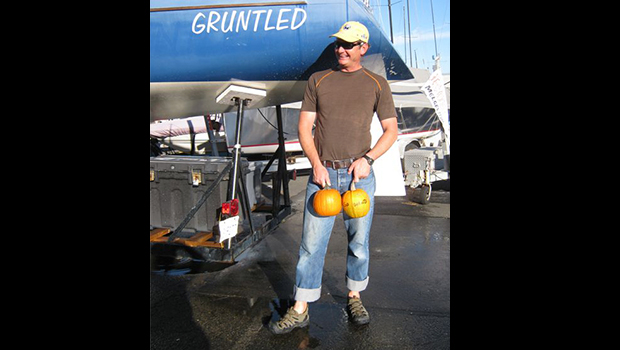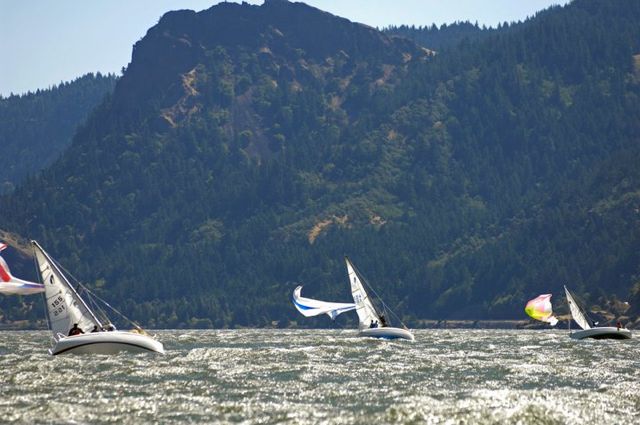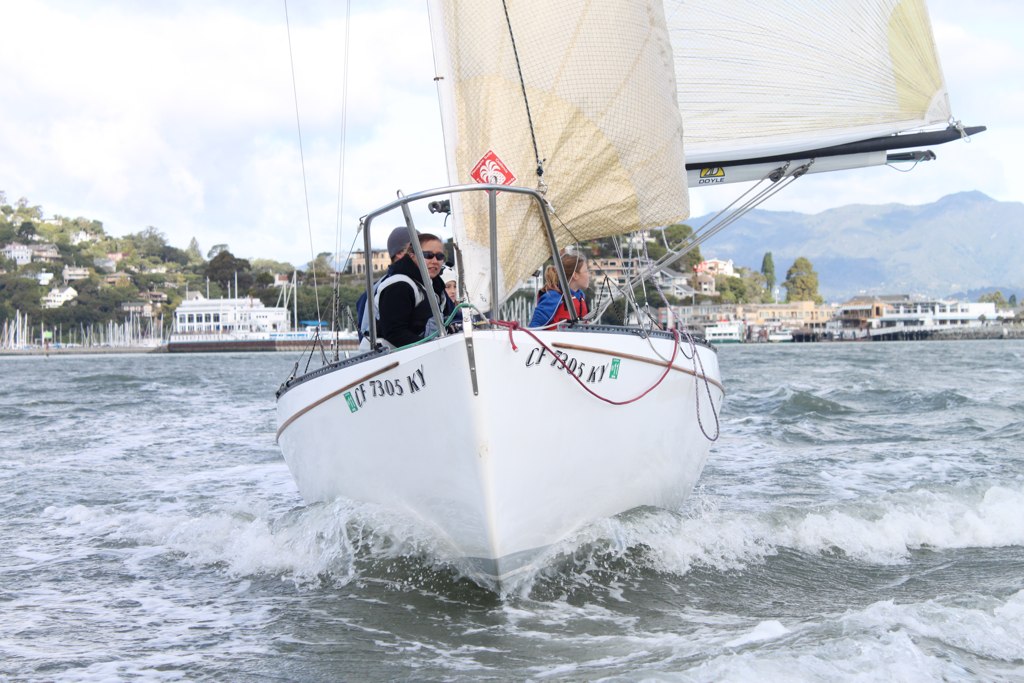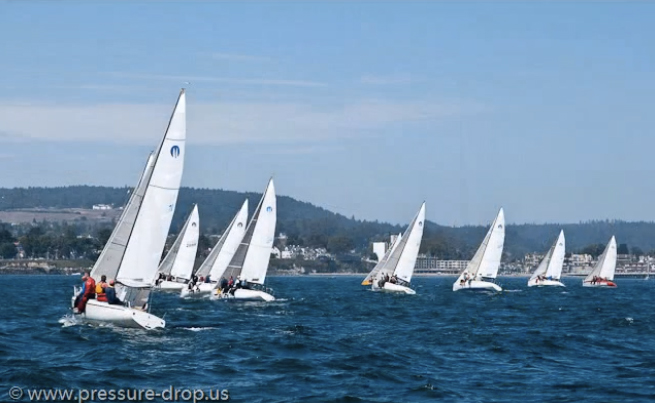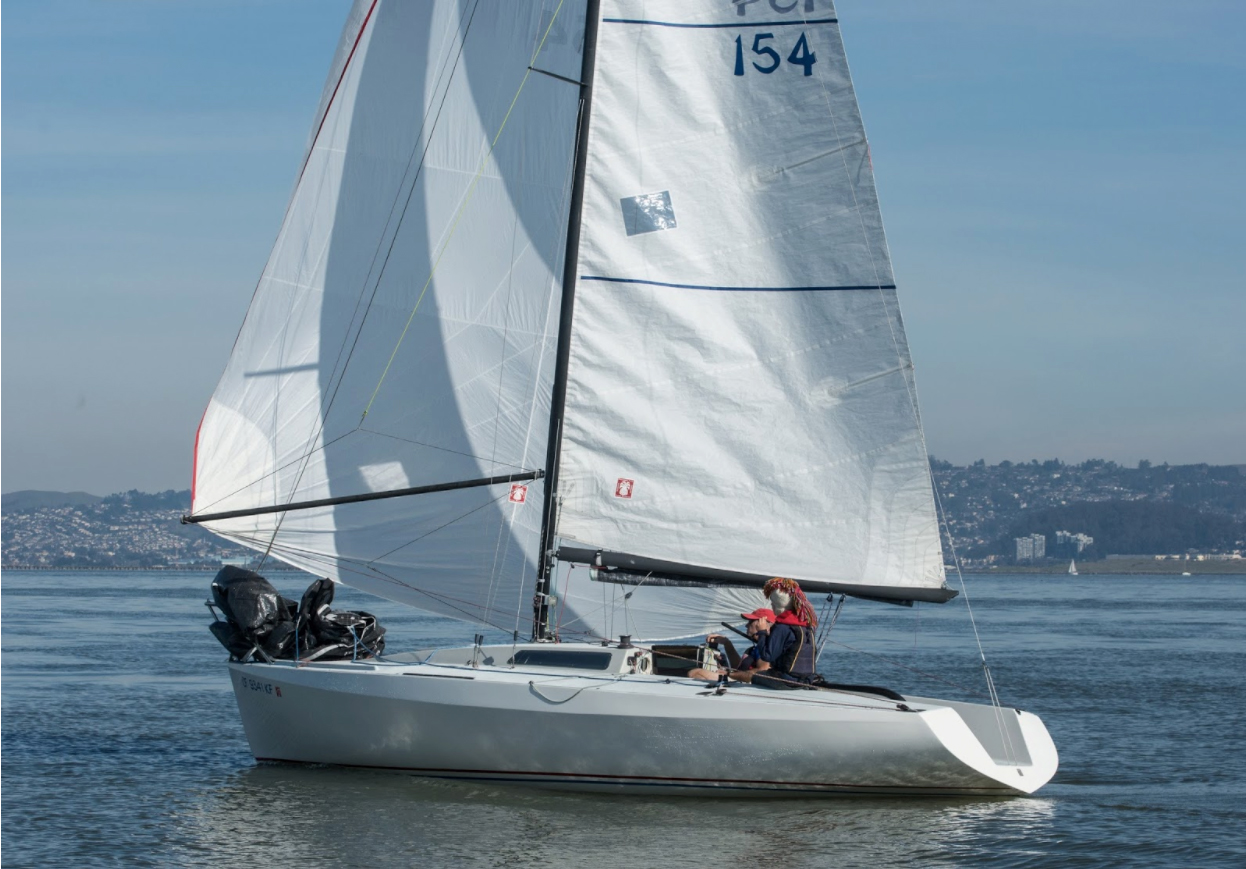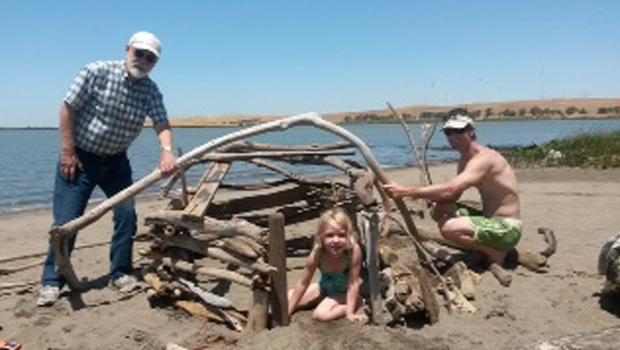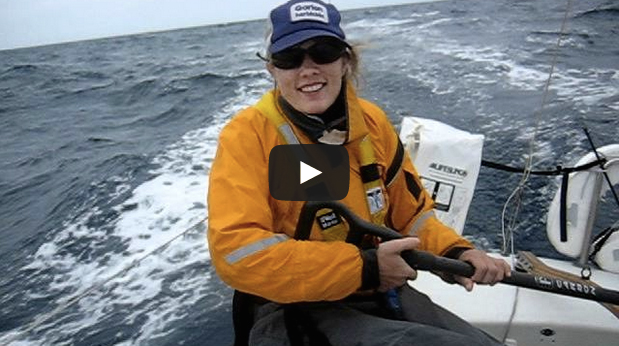
It’s a bright, sunny afternoon in early October 2010 and a fleet of 30 Moore 24s are sailing their North Americans out of Santa Cruz Yacht Club.
I’m in the hills above Santa Cruz and I’m standing in a redwood grove on the spot where the plug for a boat named Grendel, the predecessor to the Moore 24, was almost destroyed. Grendel was designed and built by the legendary yacht designer George Olson with his friend Wayne Kocher in an effort to capitalize even further on the success they had had with a previous boat named Sopwith Camel.
According to John Moore, one of the partners in Moore Sailboats at the time, 'George got his inspiration for Grendel from a drawing that he saw in a Herreshoff book. You know how it is looking at the line drawings in a book? It’s to scale. They just eyeballed the drawings I think.' Grendel was designed by taking the mathematical data from the lines they drew from the book and plugging them into a computer that was the size of a house located at Cabrillo College, making Grendel one of the first sailboats to use a computer in the design. John’s brother Ron adds, 'George was in love with this model boat that he had, it had these apple-cheek bows, and that’s what he put onto Grendel.'
The center of Olson’s boat building empire at the time was near the Santa Cruz Harbor, and John recalls. 'They made the Grendel plug right over on fifth ave. Those houses used to rent for fifty or a hundred bucks. And Grendel was out there in the driveway.' Now an area of multi-million dollar homes, it’s hard to imagine building a boat there.
George and Wayne were each going to build a boat off of the male mold, but during the construction of Wayne’s hull, the barn where it was being stored burnt to the ground and the boat was reduced to cinders. John Moore recalls, 'They built two fiberglass hulls and one of them, Wayne’s, was towed up to Bassano’s (the barn), and the mold was thrown over the bank… then the barn burnt down, and Wayne lost the boat.' Luckily, Grendel was safe and sound down in the Santa Cruz Harbor. Project development was on hold.

Grendel was sailed enthusiastically almost every Wednesday night, and its intended purpose of being a fun and fast boat to sail was realized. John adds, 'At that time, the interest for boats under 30 feet was called M-O-R-C, so George campaigned Grendel and it was a fairly successful boat, and he found the shortcomings. It needed a little more keel and a little more beam.' The male mold sat unused up under the redwoods in the hills above Santa Cruz. Ron Moore to the rescue!
With the barn reduced to charcoal, and the plug taking up space in the Bassano’s yard, it was time to clean house. Ron recalls, 'There’s a little interesting hitch when we went to rescue the plug. Dennis (Bassano) wanted to get rid of the plug. You know, the barn was burnt down, and there’s this mold sitting there. I think it was Dennis’ idea being the crazy guy that he is. He said, ‘Let’s take this thing and push it off of the cliff and ride in it down into the ravine. And probably after a bunch of Budweisers or something it sounded like a great idea. I stopped them and told them that I’d build a boat off of it.' Grendel’s plug was spared.
Ron and his buddies took the plug to their shop, nick-named The Reef, and proceeded to make plans to doctor it up and make a real go-fast boat. For as long as Moore sailboats has been around it’s been called ‘The Reef’. Ron confirms the origin 'When your boat ends up there, you’re high and dry.'
Let’s back up for a second. How did Ron and John get into boat building in the first place? They started off by building surfboards and Ron worked for another powerboat builder over the hill from Santa Cruz. John remembers, 'We had a boat shop trying to make other kinds of boats like 5o5s, Jester Dingys, El Toros, what ever it took to keep the doors open.' And this from Ron’s perspective, 'We were building surfboards at the time next to my parents house, the 1971 5o5 Worlds were being held in Santa Cruz and I just fell in love with the beauty of the hull. I analyzed the design and thought that I could make an all composite one, with minimum weight, using average materials.' So, as you can tell, the innovation within Moore Sailboats started early.
Ron adds, 'Most boats, the English boats and the Australian boats were all half wood and half glass. There was a very unsuccessful English boat that was all composite and it was heavy. Good design, but bad execution, the result was a heavy boat. I took that boat, redesigned it and made it my model, all glass.'
With the mold secure at The Reef, and the Moore brothers building 5o5s, it was time to take the data gleaned from sailing Grendel and modify the plug for the next endeavor. Ron Remembers, 'Later, George came up to me and said, ‘Let’s build a Wednesday night racer out of that old Grendel plug, with complete disregard for offshore sailing. George and I…I crawled into the plug and stood right where we thought it was too skinny and pushed as far as I could push with my arms and as far as I could extend with my feet and George stuck a 2X4 in it and then we measured it. We wanted to go a little more, so he stuck the board further in and that was it!'
John recalls 'So, we got the mold and we took the bulkheads out of it, we took the stations out of it, it was 1X1 redwood plank, and we stretched it out…But when you do that, the sheer does this, it gets kind of funny (curves hands in a funnel shape). I think that’s why the nose is kind of…it’s a little off. It’s not a perfect symmetrical boat (laughs).' Then we took a male hull off of that and it became Summertime. We just faired it, we didn’t make a mold off of that, we made a complete boat and sailed it around for I think a year or two.' Summertime was born, and can still be seen sailing (and winning races) in the waters off of Santa Cruz today.
What about the famed asymmetrical hulls? Yeah, they’re lopsided, but as Ron points out, 'The thing that makes the hull asymmetrical is the way that I pushed and the way that the material yielded. Everybody likes to say it’s 2 inches off, but they’re lying motherfuckers. It’s an inch and a half, but technically, if you go from the centerline, it’s 5/8th of an inch off. Not bad for total back yard, Oakie endeavor.' I asked some of the top sailors at this year’s Nationals if the boat had any noticeable characteristics on either port or starboard that they could attribute to the hull being off kilter. They had nothing.
Summertime made asuccessful Wednesday night Beer can campaign debut and caught the eye of several of the Moore brother’s friends and the suggestion was made to build a few more at The Reef. John, adds, 'Summertime was just supposed to be, you know, a Wednesday night fun boat to sail, and it still is! After a while we started to think, ‘this thing goes pretty well’. I can’t remember who said it, maybe Jack Halterman or Rob Wade, or someone. ‘We should build a couple of these.’ The AP was down and it was time to put on their game face.

They made a mold off of Summertime and went into production. The first few boats are difficult to trace, but several of them can be found in various places around Santa Cruz and The Bay Area. John comments on Ruby, the first official Moore 24 'Ruby, the oldest boat sailing in this event (the current 24 Nats) I believe, and was our shop boat. It was supposed to have been my boat.' Ron agrees, 'Up until hull number 5 the boats were kind of crude, Ruby is the first one I really called a Moore 24.' Ruby just had a major refit, including the addition of an open transom, by the ‘Fleet Surgeon’ Craig Smith, owner of Elkhorn Composites in Watsonville. More on Craig in a moment.
The early boats had a flush deck and were sold as hulls only. The going rate in the early 1970s was around $6000, making the Moore 24 one of a handful of plastic boats that has actually appreciated in value. John recalls, 'The early boats were sold as sort of a kit, we just sold the customers a hull, and then later all the stuff that goes with it. If the guy couldn’t build a rudder or a keel then it would come back and we’d build them.'
Through the lifespan of Moore Sailboats, they produced around 160 Moore 24s. Though the Moore 24 is mostly a West Coast class, there are several other places that you can find these little 24’ keelboats. The boats have won all kinds of sailing events, offshore to HI, Farallones races, a multitude of coastal distance races to Wednesday night beer cans. The Moore 24 has proven its self offshore capable, and stable enough to take out in serious conditions. It’s very trailer able and works well as a compact overnight family boat. And as John states, 'Who would have ever suspected that these boats would have lasted this long?'
What about when the boats get wrecked or go under the knife for a new-fangled open transom? Enter Craig Smith, the fleet’s surgeon that I introduced you to earlier. Craig is the ultimate composites engineer, he can fix just about anything that’s made out of resin and glass. Smith is a philosopher; he gets into the soul of the boat and repairs it with his brand of esoteric magic that emanates from 80 grit sand paper spinning on a grinder or from gel coat that sprays from the tip of a spray gun. Craig is a magician; He can make the evidence of a bad day of racing disappear with a touch from his artist brush.
Smith, a longtime sailor, boat builder and soothsayer has a page in the Santa Cruz boatbuilding history book. His company, Elkhorn Composite Services is right next door to Moore Sailboats in Watsonville. He knows a lot of the history of Moore Sailboats from having worked with Ron. Some of the tools and gear in the shop came from the Chicken Coop when it closed down, so there’s a family history of sorts within Elkhorn Composites. Craig explains, 'I helped take down the shop at Bill Lee’s. The hoist right there (points up) came out of it, some of the tools here came from there, and even from that experience I can see the clever thought that went into all of these Santa Cruz boats.'
For various reasons, several owners have installed open transoms, Craig has installed 4 of the open transoms and has done countless repairs for the Moore fleet, he explains, 'On occasion, boats get damaged in a way or they’re neglected in such a way and it becomes eligible, and because a gentleman named Gary Tracy did it. He took a reject hull out of Moore’s yard that was non-numbered hull, he took it up to Bill Lee Yachts and rented a deck mold from Ron Moore and had this idea to make a modern looking boat. So he led the way. Some people liked it so they ordered open transoms from ‘Garsky’ and he probably did 6 or so before he passed away. Before he died, he sold his boat, Bruzer to Morgan (Larson).' The open transom isn’t just for looks, it allows the cockpit to drain faster and gives a little more room for the driver and crew.
The open transom isn’t just for looks, but hey, if it looks cool too, Craig Comments, 'The boats are anthropomorphic. I get two or three boats in here and people are always drawn to the Moore 24. They look at the other boats that look like That 70s Show and with the Moore, if you open the transom up I looks like a modern boat. It’s a timeless shape that nobody can claim as their own.' Craig’s fondness for the Moore shines through.

The open transom isn’t for every boat, but if there’s a need to get into that area it’s much easier to cut the deck out rather than crawl into that tiny space, 'I had a major repair to do on a boat called Moore Havoc that was rear ended on the way back from the Ditch a few years ago, and instead of crawling back in there, we made the decision to just open up the transom. I took a mold off of Bruzer, built the part, and put it together. All together we’ve done four of them. I won’t cut into a nice boat, they have to be eligible.' It takes about 50 hours and some mad fiberglass skills to pull off an open transom conversion.
Three of the top four boats have been into Elkhorn Composites in the past month having various things repaired, so I asked Craig if his service had anything to do with the high placement in the regatta. 'We tart them up. I won’t call it fairing because we’re not templating anything. We’re not adding putty, it’s more like precision sanding. We do a nice job sanding the bottoms and I pays off, the boats are squirty like little watermelon seeds. We always leave the inconsistencies in the hull, like there’s always a little crooked part abaft the keel, it’s always there. The molds were so hokey…so we maintain a certain level of crappyness in all of our Moore work. We’re not doing what some people would like us to do, make them perfect, they’re inherently imperfect.' So yeah, maybe Craig had something to do with the boats performing well, but we’re talking about Morgan Larson, Philippe Kahn and Dave Hodges, three ‘A’ fleeters to say the least.
And Craig, coming from a boatbuilding background, appreciates the creativity and diversity of talents that it took to get these early Santa Cruz ULDBs afloat, 'You have hot rodders, you have surfers, boaters, welders, mechanics, and artists in steel and you hardly ever see that type of innovation embodied…I wasn’t here to see it first hand, but I see it every day in the boats that I work on. I feel very fortunate to have met some of these guys. I would have hated to be in business back then, when the surf was good nobody came to work. The guys building the boats weren’t guys that you could count on to come to work every day, but you could count on them to come up with bitchin ideas and execute these beautiful three dimensional curvy shapes, which is very different from building cabinets.'
Local Philippe Kahn, known for going big on Open 50s across the Pacific, joined this small localized fleet, showing that you don’t need a giant, expensive toy to come out and have a good competitive time racing. Hats off to Pegasus for making the effort to get a boat dialed in for the Nats! It’s cool to have the support of such a legitimate syndicate in such a small hometowny-feeling fleet.
The races started in light winds and a decent South Swell. The wind was from the North West, starting out Easterly in the morning then completely dying out in the afternoon. In race one, Bruzer crossed the line first, with the oldest boat in the fleet crossing in second place and Pegasus- Motion X in third. In Race 2, Eight Ball took the first spot and local boy Dave Hodges on Adios crossed in two followed by Pegasus. The boats gratefully accepted a tow from Outrageous.











